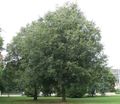Hackberry trees
| Hackberry trees | ||||||||||||
|---|---|---|---|---|---|---|---|---|---|---|---|---|

European nettle tree ( Celtis australis ) |
||||||||||||
| Systematics | ||||||||||||
|
||||||||||||
| Scientific name | ||||||||||||
| Celtis | ||||||||||||
| L. |
The hackberry or nettle trees ( Celtis ) are a genus of the hemp family (Cannabaceae). Previously, the genus was classified in the elm family (Ulmaceae).
distribution
The nettle trees occur as deciduous species in the northern temperate zone and as evergreen species in the tropics. The main area of distribution is East Asia.
description
Celtis species are trees or shrubs and sometimes form root saplings . The bark is usually gray. The alternate and two lines are arranged on the branches leaves are stalked and have a serrated edge. They are three-nerved at the base and the lateral nerves always curve in front of the leaf margin towards the tip and merge. Stipules are present, but they fall off early.
The inconspicuous flowers are mostly unisexual, rarely hermaphroditic. The male flowers are in clusters in the lower part of this year's branches. The stalked hermaphrodite flowers sit individually, axillary separate in the upper part of the branches.
Hedgehog trees form spherical stone fruits . In some species, the red to black pulp is edible, even if the seeds it contains are very large. These fruits have been collected since the Epipalaeolithic at the latest , as evidence from the Öküzini cave in southwestern Turkey shows .
Systematics and distribution
The genus that occurs worldwide in temperate climates comprises 60 to 100 species , including:
- Celtis adolfi-friderici Engl .: Central, West Africa
- European hackberry , also southern hackberry, ( Celtis australis L. )
- Celtis biondii Pamp. : It occurs in China, Japan, Taiwan and Korea.
- Bunges hackberry ( Celtis bungeana flower ): China and Korea
- Celtis caucasica Willd. : Caucasus, Asia Minor, Western Himalayas
- Celtis cerasifera C.K. Cutting. : It occurs in China.
- Celtis chekiangensis W. C. Cheng : It occurs in China.
- Celtis jessoensis Koidz. : Japan, Korea
- Celtis julianae C.K. Cutting. : Central China
- Celtis koraiensis Nakai : Korea, Manchuria, North China
- Celtis labilis C.K. Cutting. : Central China
- Smooth-leaved nettle tree ( Celtis laevigata Willd. ): Eastern United States and northeast Mexico
- Celtis Lindheimeri Engelm. ex K. Koch (Syn .: Celtis helleri Small ): This species grows at altitudes between 100 and 200 m above sea level from Texas to northern Mexico.
- American hackberry ( Celtis occidentalis L. ): This species grows at altitudes from 0 to 1800 m above sea level in large parts of North America. This species is used as an ornamental plant because of its tolerance to drought.
- Celtis pacifica planch.
- Celtis pallida Torr. (Syn .: Celtis spinosa Spreng. Var. Pallida (Torr.) MCJohnst. , Momisia pallida (Torr.) Planch. ): It grows at altitudes between 1000 and 1300 m above sea level in Arizona, Florida, New Mexico, Texas, Mexico, Central America , South America (to northern Argentina).
- Celtis philippensis Blanco : This species grows in the monsoon forest in limestone areas at altitudes from 0 to 1000 m above sea level in the Chinese provinces: Guangdong , Hainan and southern Yunnan ; in Taiwan , India , Indonesia , Malaysia , Myanmar , the Philippines , Sri Lanka , Thailand , Vietnam , Africa, Australia and the Pacific Islands.
- Celtis reticulata Torr. (Syn .: Celtis brevipes S. Watson , Celtis douglasii Planch. , Celtis laevigata Willd. Var. Reticulata L.D.Benson , Celtis occidentalis L. var. Reticulata (Torr.) Sarg. , Celtis reticulata var. Vestita Sarg. ): This species grows at altitudes between 300 and 2300 m asl in the USA and in northern Mexico.
- Celtis sinensis Pers. : Japan, Korea, East China
- Celtis tenuifolia Nutt. (Syn .: Celtis georgiana Small ; Celtis occidentalis L. var. Georgiana (Small) Ahles , Celtis pumila Pursh var. Georgiana (Small) coffin. , Celtis tenuifolia var. Georgiana (Small) Fernald & BGSchub. , Celtis tenuifolia var. Soperi B. Boivin ): This species grows at altitudes from 0 to 500 m above sea level in the USA.
- Celtis tetrandra Roxb. : It occurs in India, Nepal, Bhutan, Pakistan, Bangladesh, Thailand, Indonesia, Myanmar, Vietnam, Taiwan and China.
- Celtis timorensis Spanoghe : It occurs in India, Nepal, Bangladesh, Malaysia, Indonesia, Sri Lanka, Myanmar, Thailand, the Philippines, Vietnam and China.
- Tourneforts hackberry ( Celtis tournefortii Lam. ): Asia Minor , Southeast Europe
- Celtis vandervoetiana C.K. Cutting. : It occurs in China.
A fossil type is:
- Celtis lacunosa † ( Reuss ) Church. : From the Miocene of Europe
Illustrations
Western hackberry ( Celtis occidentalis ):
European nettle tree ( Celtis australis ):
swell
- Liguo Fu, Yiqun Xin & Alan Whittemore: Ulmaceae in the Flora of China : Volume 5, p. 15: Celtis - Online. (engl.)
- Description of the genus in the Flora of North America. (engl.)
Individual evidence
- ^ Danièle Martinoli: Food plant use, temporal changes and site seasonally at Epipalaeolithic Öküzini and Karain B caves, southwest Anatolia, Turkey. In: Paléorient 30/2, 2004, p. 70 ( JSTOR 41496700 , accessed on August 26, 2015).
- ^ A b c Celtis in the Germplasm Resources Information Network (GRIN), USDA , ARS , National Genetic Resources Program. National Germplasm Resources Laboratory, Beltsville, Maryland. Retrieved May 1, 2017.






